If you’re just getting your first generator or at least thinking about it, I’m sure that you’ve heard that you need either a transfer switch or an interlock kit installed before you attempt to power your house. While either one are technically not required in order to power your house in theory, they are often required by your local laws, codes, and are, in general, a very good thing to implement.
A transfer switch and an interlock kit both make it impossible to backfeed generator power through the utility power lines. An interlock kit does this by creating a physical barrier on the main breaker box to ensure the mains breaker and the generator breaker cannot be turned on at the same time, whereas a transfer kit accomplishes this with a switch after much rewiring has occurred.
In this article I’m going to talk about why a transfer switch or interlock kit is needed, the big differences between the two, the costs involved, and what one is likely the best option for you.
Grab a quick cup of coffee and lets jump right in!
Why is a Transfer Switch or Interlock Kit Needed?
First and foremost, the physical safety of line crew workers who are attempting to fix the power lines during a power outage is why we use a transfer switch or an interlock kit.
When properly installed, both options make it physically impossible to back-feed electricity from your generator to the power lines outside. If this were to occur, you could easily kill an unsuspecting line worker. It happens every year. Here is a story from my state that occurred just last fall. They will investigate and you will be charged with the person’s death if you do something like that.
You can technically back-feed your house without a transfer switch or interlock kit, as long as the mains power is shut off in your breaker panel. I’m not going to get into the details of how to do it, since I don’t recommend it, but it can be done.
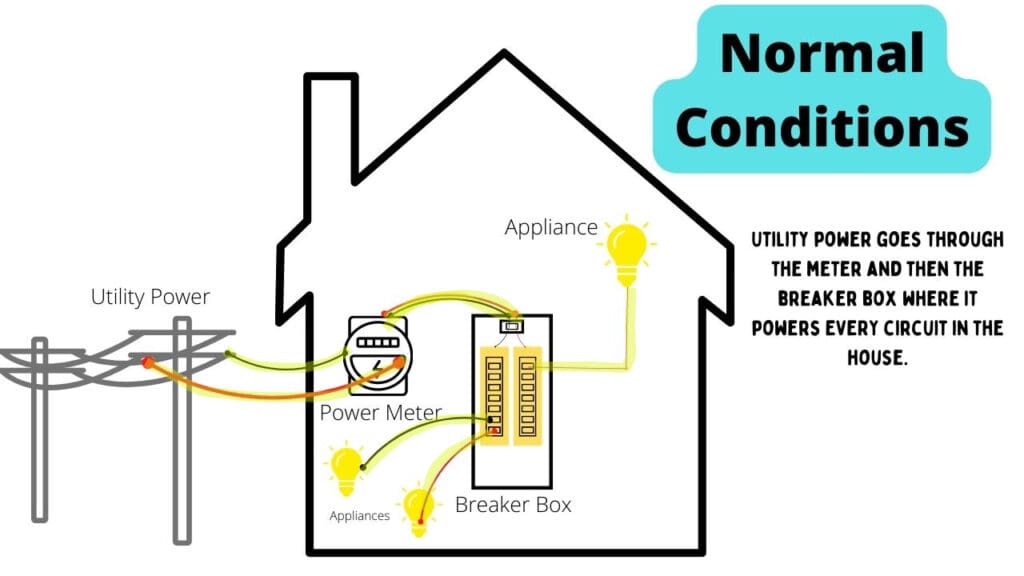
One of the most common mistakes people make when back-feeding a house without a transfer switch or interlock kit is that they remember to turn off the mains breaker when they start the process, but after a few hours they’ll turn on the mains breaker — without turning off their generator first — for a few moments to see if the power came back on to a circuit that they are not powering with the generator. Those few seconds of absentmindedness are not harmless and a very lethal event to someone who is just trying to do their job and go home to their family at the end of the day.
If you’re going to use a generator to power your house, your insurance company is going to want a transfer switch or interlock kit installed, your local codes and laws are likely going to require it, and you’re just leaving yourself (and a line worker) at the mercy of Murphy’s Law if you happen to skip their installations.
Big Picture Difference Between Transfer Switch and an Interlock Kit
Okay, now that we’ve gone into why it is critically important to have a transfer switch or an interlock kit installed, you’re likely wondering which one you need installed.
We’ll cover which one is likely best for you a little later, but we must first understand how both of them operate first. I’ll keep this high-level so that we don’t get bogged down in the weeds and electrician speak.
A transfer switch is a separate breaker panel that is installed near your main breaker box and reroutes a set number of circuits from your main breaker panel to itself first. It has a direct connection with your generator’s incoming power and the mains power from your power company. A switch can be physically toggled to either power the entire house with the mains power, or the power can be directed to the generator where only the set number of circuits can be powered. A transfer switch makes it physically impossible to back-feed any electricity into your house from your generator if the connection with the mains power hasn’t been severed.
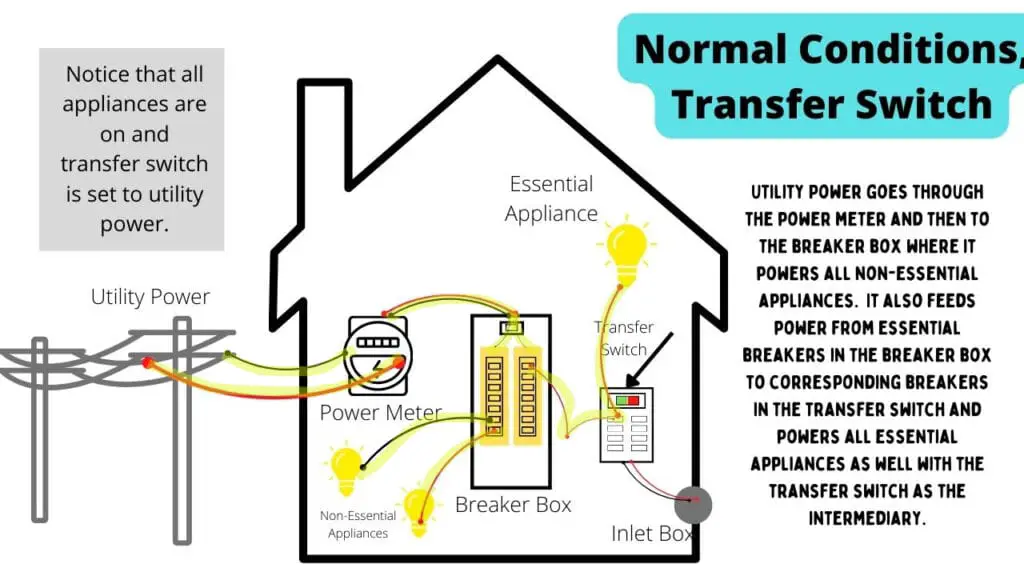
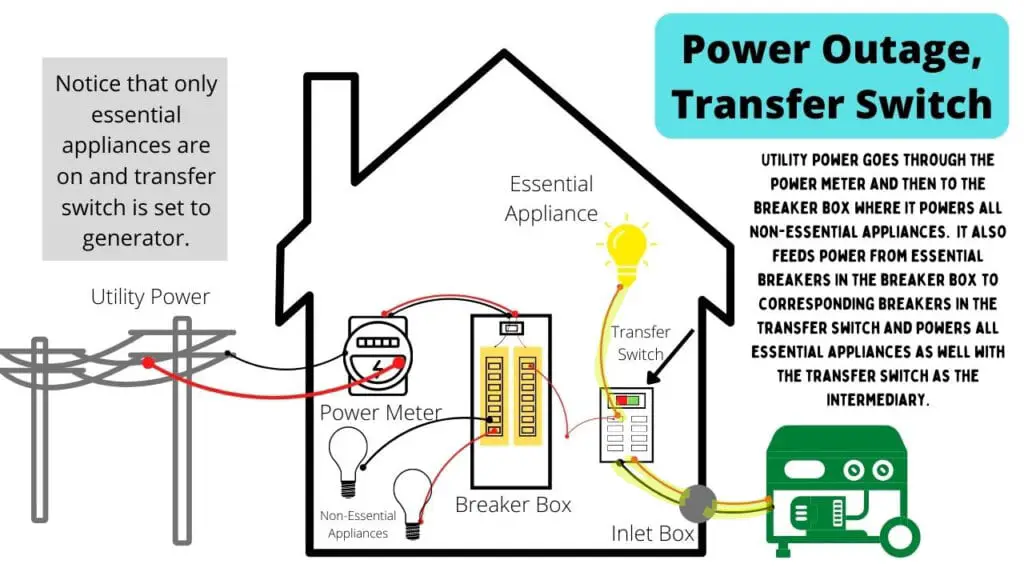
An interlock kit is mounted directly onto your main breaker box and is a sliding mechanism that only moves in two positions. In one position it physically blocks the breaker switch for the generator’s incoming power while the mains power is turned on. To move it to the second position where the breaker for the generator’s incoming power is accessible, the mains power must be turned off and then the switch is physically blocked from being able to be turned back on while the generator is backfeeding the house. Turning on the mains power again would then require that the generator’s breaker be turned off and the interlock slid in place to physically block it once again.

Just as with a transfer switch, an interlock kit (when properly installed) will make it physically impossible to back-feed the mains power with your generator.
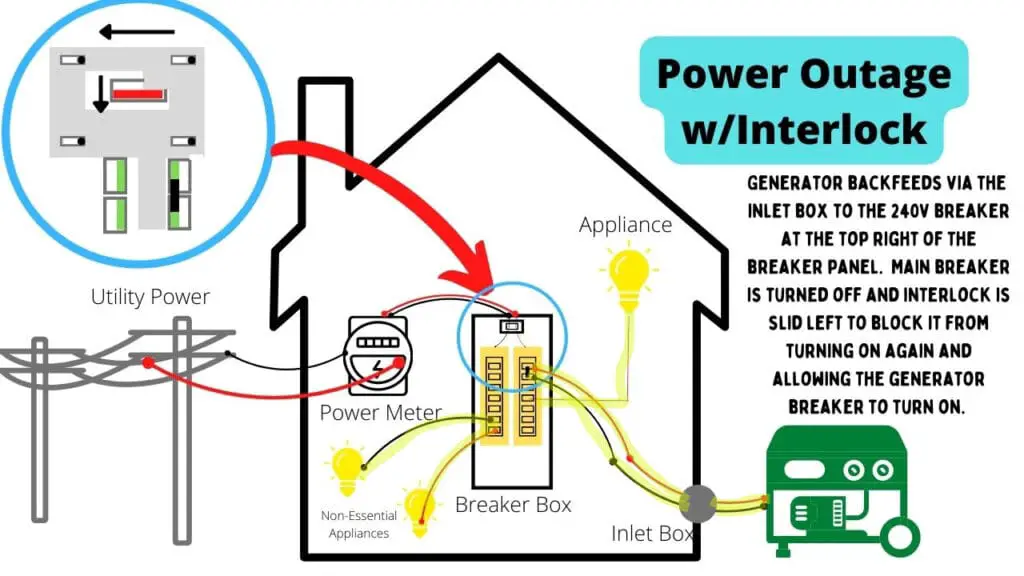
What is a Transfer Switch
When you install a transfer switch, you’re essentially mounting a box on the wall beside your main breaker panel that looks like a mini breaker box or subpanel.
It will generally have 8-10 circuit breakers on it and will have a switch on it that will connect to the mains power from your power company, or to the generator.
How this process works is that you will first decide which breakers on your main panel that you would like to be able to power with your transfer switch. Remember that a 240-volt circuit will take up two of the spots on a transfer switch.
Typically, people will choose the water well (if you’re not on municipal systems), the breaker that the sump pump is on, the kitchen, bedrooms, etc. Whatever you find the most urgent in a power outage situation. However, you will be limited to the number of breakers that are on the transfer switch.
Your local certified electrician will then interrupt and route the hot wires from each your selected breakers in your main panel to the corresponding breakers in the transfer switch itself. They will also set up the neutral and ground wires as well.
In normal circumstances, when all is said and done, the utility power will feed your non-essential circuits and appliances (those not in your transfer switch) directly through the main breaker panel. Your essential circuits will also be powered, but they will have the transfer switch as the new intermediary.
On the flip side, when the power is out and you go to use your generator, you will physically toggle the switch on the transfer switch so that it will break its connection with your utility power (saving line workers from incorrectly backfeeding the house) and the generator will now be able to power any of the circuits on the transfer switch that you have turned on.
Whether you keep all of the circuits turned on while using the generator will depend on your generator’s output and the power demands of each of the circuits.
For instance, if you had a 5,000-watt generator and had a circuit to your well pump, your fridges and freezer, your electric range, your window AC unit, your lights, and your sump pump — you could certainly run any of those with the generator but not all at the same time. You’d have to mix and match your breakers to stay within the limits of the generator’s output.
Transfer Switch Key Points:
- Only a limited number of pre-selected essential circuits can be powered
- Separate box (the transfer switch itself) is mounted near your main panel on the wall
- Switched neutral and shared neutral varieties are available (see below)
- $400-$500 for parts & $300-$500 for professional labor to install
- Make it impossible to back-feed generator power through the utility power lines
- If your non-essential circuits turn back on (the ones not linked to the transfer switch), you can easily tell when power is restored
Switched Neutral vs. Shared Neutral Transfer Switches
I won’t spend too long on this topic, but when your electrician installs your transfer switch you will want to know if you have a switched neutral or a shared neutral transfer switch.

Basically, a shared neutral transfer switch does not break the connection with your home’s neutral when the generator is powering the home and only switches the hot wires. The house itself has the neutral and ground bonded at the main disconnect in the event of a fault current so that it has an emergency path back to the source. The house also has a ground rod.
Your generator is sharing this emergency fault path with the neutral remaining intact.
In this case, your generator would need to be a floating neutral since you cannot have two places where the system is bonded or you will create parallel paths back to the source during a fault or even during normal operation. You will also not need a ground rod installed.
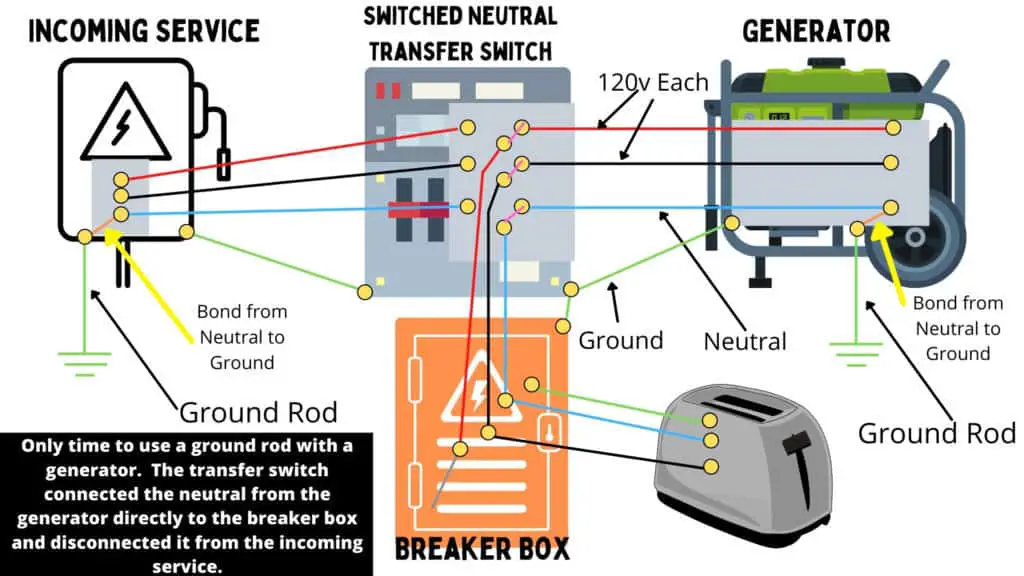
If you have a switched neutral transfer switch, then when you toggle the switch to go from utility power to the generator not only are the hot wires switched but the neutral as well. This means that the generator no longer shares an emergency fault path with the house and must rely on itself via proper wiring.
This means that your generator needs to have a bonded neutral and in this case it needs to have a ground rod as well since it is now a separately derived system according to the NEC.
I have a full article that you can check out here that covers ground rods and bonding in easy to understand language with lots of cited sources. I highly encourage you to check it out if this seemed like a foreign language.
How Much Does a Transfer Switch Cost?
The transfer switch, wiring, and any required breakers should cost about $400-$550 for the parts themselves if you were to do the job yourself. Hiring out the job to a licensed electrician will likely cost a total of $700-$1,000 and can be finished in less than a day.
If you have any reservations about doing this process yourself, then I can’t recommend enough that you hire the work out to a licensed electrician. Electricity is invisible and deadly and should not be messed with unless you are fully certain about what you are doing.
What is an Interlock Kit (many types, cost)
Interlock kits are relatively simple and straightforward when compared to their transfer switch counterparts. There is no wiring involved. There is no new box added.
An interlock is simply an odd-shaped piece of flat metal that is allowed to move in one of two positions. It either allows for the main utility breaker to be turned on while physically holding the breaker for the generator in the off position, or it allows for the generator breaker to be engaged while physically holding the main utility breaker in the off position. The two breakers cannot physically be turned on at the same time and therefore you cannot accidentally kill a line worker by back-feeding the utility lines.
Interlock kits will come in many shapes and sizes and you need to match it to your current setup and specific breaker panel. They almost always (I haven’t found an exception) require that the 240-volt dual breaker that you’re using to back-feed your generator power be located at the top position of the panel and below the mains breaker.
If the 240-volt circuit that you are using to back-feed the house with the generator is in a place that doesn’t match up with an available interlock kit, you may need to have a licensed electrician move it to a different place on your main breaker panel.
Interlock Kit Key Points:
- No rewiring required (unless 240-volt back-feeding breaker is not located at the top of the panel)
- No separate box to install
- Simple installation with a few screws
- Interlock must match your specific make and model of breaker box
- Cannot tell if power is restored without first shutting off the generator, moving the interlock, and testing the mains power
- Can potentially power any circuit in the home with the generator (but likely not at the same time)
- Cost usually around $30-$75 for parts, $200-$300 for labor to do any required wiring if the 240-volt back-feeding breaker needs to be moved
Is a Transfer Switch or an Interlock Kit Best for You?
Now that you know how they work, you have to now decide what is best for you in your particular situation.
If you’re still wondering what size generator you need to power your house and appliances, I have a detailed article here that will guide you through five simple steps to find your match.
In my opinion, a transfer switch is great for someone with a mid-sized generator under 10kW in output. Since your generator’s output is limited compared to grid power, having to carefully select which circuits are most important to you will reduce the likelihood of you overloading your generator.
Since an interlock kit will still allow you to power any circuit in your house from the main breaker box, it would work better when you have a larger generator (10kW+) since the risk of accidentally overloading the generator would be much smaller.
If you’re still in doubt, I recommend consulting with your local licensed electrician.
Regardless of which one you choose, it is critical that you pick one of them before back-feeding your house in order to ensure that you are eliminating the possibility of killing a line worker who is just trying to get the lights back on for you.
